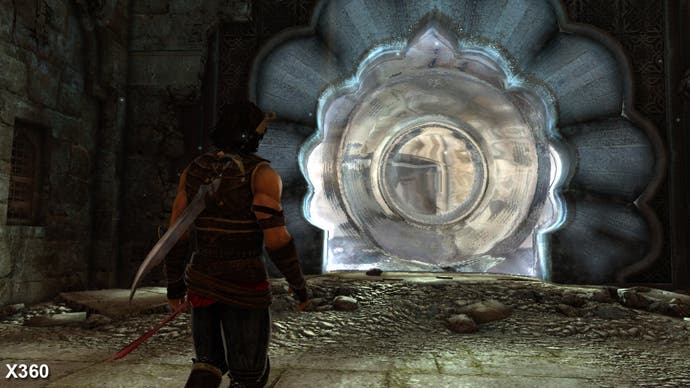Xbox 360 vs. PlayStation 3: Round 26
Split/Second, Lost Planet 2, Green Day: Rock Band, Prince of Persia and Backbreaker.
Prince of Persia: The Forgotten Sands
| Xbox 360 | PlayStation 3 | |
|---|---|---|
| Disc Size | 4.6GB | 4.92GB |
| Install | 4.6GB (optional) | 1304MB |
| Surround Support | Dolby Digital | Dolby Digital, 5.1LPCM |
Prince of Persia: The Forgotten Sands sees a marked departure from the cartoon appearance of the previous game, with a graphical style more closely related to the intricate, realistic look of Assassin's Creed.
It's an interesting switch, but not entirely successful. It's as though much of the individuality of Prince of Persia has been sucked out of the game: the freeform structure of the world has gone in favour of a more linear approach, while the sense of adventurous exploration feels almost completely absent since the path through the levels is obvious.
In terms of the quality of each version, Ubisoft is getting good at providing like-for-like experiences with its tentpole titles. For a while now its cross-platform output has been of a consistently decent standard, and with Prince of Persia: The Forgotten Sands, we see that the developers are making efforts in paring back the scale of the sometimes-whopper mandatory installs we've seen in the past on Ubi titles such as the Tom Clancy's HAWX and EndWar.
Visually though, these games are very close indeed, as the comparison footage shows:
What we're seeing here is a classic 720p framebuffer with 2x AA on both platforms. That will be the more usual MSAA on Xbox 360, but quite what we're seeing with the PlayStation 3 version isn't so clear.
There's the overall blur we would associate with quincunx, but many of the smoothed edges don't seem to quite correlate with what we would expect from QAA. Regardless, for a game where we have high quality, intricate art, any blur isn't really that welcome and there is an undoubted crispness and precision on the 360 build that you don't quite get on PS3.
Other differences between the two versions appear to be either minimalistic or just simple bugs. The Xbox 360 uses alpha-to-coverage for grass, while PS3 employs alpha test. We also see a scene with a pretty dramatic difference - in the portal area, PS3 uses a depth-of-field post-process entirely absent on 360.


Moving onto the performance side of things, we see a game that offers a small advantage to the Xbox 360 build. Both versions follow the time-honoured pattern of being capped at 30FPS, invoking screen-tear when any particular frame takes too long to render. Indeed, POP on PlayStation 3 uses another technique we're seeing increasingly come to the fore - the soft v-sync.
What happens is that the hard and fast 33.33ms budgeted to each game is a touch more fluid on the PS3 version, meaning that there is a constant tear at the top of the screen on every other frame of the 60Hz output.
From what we've heard this allows developers to manage tearing more effectively and keep it away as much as possible from the centre of the screen, where it has most impact on visual quality. Of course, any such tearing is basically invisible to the human eye, but not to our tools.
The soft v-sync plays havoc with performance analysis graphs, so we effectively crop the top 10 lines from the analysis to produce a readout more in line with what the human eye perceives.
You'll note that most of the tear lines on the PS3 side of things barely have any red, meaning that the tear is still very high up on the display, and again almost certainly unnoticeable (the point is that we need to have a cut-off point somewhere so these readings are unavoidable).
Happy days, then, in terms of what matters: the player experience. We have what is, to the human eye at least, a game that is effectively v-synced for the vast duration of gameplay on both platforms, with only one standout section that shows any kind of tangible advantage to the 360.
The bottom line is that frame-rates - by and large - are consistent and performance is very good on both systems. While Prince of Persia has still yet to achieve the level of greatness attained by some of its illustrious forefathers, players certainly won't be let down by any technical issues.
This is a solid release on both consoles with 360 just ahead by a nose owing to the blur factor - or lack of it.
- Comparison Gallery
